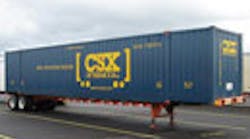The cornerstone for a massive network of intermodal facilities aimed at creating a more efficient freight link between the Mid-Atlantic ports and the Midwest is now being laid in North Baltimore, OH, the eventual home of the new Northwest Ohio Intermodal Terminal. The first step in creation of what is being called the National Gateway, completion of the Ohio terminal is expected by 2011.
Unveiled in May last year, the National Gateway public-private project is being headed by rail giant CSX Corp. through its CSX Intermodal division. The railroad is ponying up $300 million of the project’s estimated $840 million price tag to enhance three existing rail corridors that run through Maryland, Virginia, North Carolina, Pennsylvania, Ohio and West Virginia. The plan calls for completing the entire network of intermodal terminals by 2015.
The gateway intermodal corridors include the I-70/I-76 Corridor between Washington, D.C. and northwest Ohio via Pittsburgh; the I-95 Corridor between North Carolina and Baltimore via Washington, D.C.; and the Carolina Corridor between Wilmington and Charlotte, NC.
Michael Ward, CSX’s CEO, said public funding will be used primarily to raise the clearances under bridges and tunnels, enabling the movement of double-stack railcars that will allow trains to double their load capacity. Private funding from CSX and its affiliates will be primarily dedicated to building intermodal terminals, such as the one now under construction in North Baltimore, he said.
CSX said it’s already started developing four terminals that are a key component of the National Gateway, and once public funding is secured, the project could be completed in four to five years.
"The challenge of meeting our nation’s surface transportation needs is too big for any single industry – never mind any single company – to accomplish independently," Ward said at a ground breaking ceremony for the new Northwest Ohio Intermodal Terminal. "This partnership you see here today exemplifies the future of our nation’s transportation infrastructure."
Over a 30-year period, CSX noted, the National Gateway is expected to CO2 emissions by over 12 million tons, save businesses over $3.5 billion in shipping costs, reduce fuel consumption by nearly 1 billion gallons, and reduce congestion on the highways, largely by converting approximately 3 billion freight highway miles to rail, the company noted.
This multi-state intermodal effort is also intended to improve freight flows as volumes increase significantly over the next decade and a half. The Dept. of Transportation forecasts that by 2020, overall freight tonnage hauled in the U.S. will have grown by 70% from 1998 levels. The National Gateway infrastructure initiative is designed to address that growth, CSX said, and relieve pressure on the nation's capacity-strained freight network.



